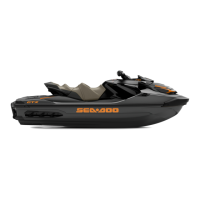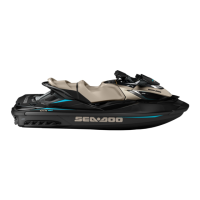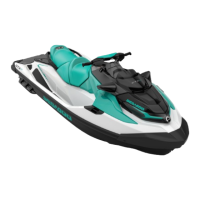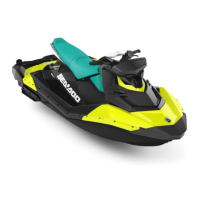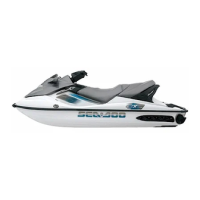Section 07 ENGINE MANAGEMENT (DI)
Subsection 01 (OVERVIEW)
This engine management system controls both
the fuel injection and the ignition timing.
As shown in the DI CONTROL SYSTEM illustra-
tion, the MPEM is the central point of the fuel in-
jection system. It reads the inputs, makes com-
putations, uses pre-determined parameters and
sends the proper signals to the outputs for proper
engine management.
The MPEM also stores the fault codes and general
information such as: operating conditions, vehicle
hours, serial numbers, customer and maintenance
information.
Electronic Fuel Injection
The MPEM reads the signals from different sen-
sors which indicate engine operating conditions at
milli-second intervals.
Signals from sensors are used by the MPEM to
determine the injection parameters (fuel maps) re-
quired for optimum air-fuel ratio.
The CPS and both TPS are the primary sensors
used to control the injection and ignition timing.
Other sensors are used for secondary input.
NOTE: The EGTS does not provide control inputs
to the MPEM. Its sole purpose is to protect the
exhaust system components by emitting a warn-
ing signal in the event of overheating.
Ignition Timing
The MPEM is programmed with data (it contains
ignition mappings) for optimum ignition timing un-
der all operating conditions. Using engine operat-
ing conditions provided by the sensors, the MPEM
controls the ignition timing for optimum engine op-
eration.
Knock Sensor
A knock sensor is mounted on top of the cylinder
head. It detects specific vibration that would be
typically generated by engine detonation. If deto-
nation occurs, the knock sensor detects it and the
MPEM retards the ignition advance temporarily (it
goes in a specific mode) until detonation stops.
Engine Modes of Operation
The MPEM controls different operation modes of
the engine to allow proper operation for all pos-
sible conditions: Cranking, start up, idle, warm
up, normal operation, Sea-Doo LK™ (learning
key) (limited vehicle speed), engine speed limiter,
flooded engine and limp home (see below).
Flooded Engine (drowned mode)
If the engine does not start and it is flooded, pro-
ceed as follows:
Remove spark plug cables and connect them on
the grounding device.
Remove spark plugs and dry them using a rag.
Cover spark plug holes with a rag.
While engine is stopped, depress and HOLD the
throttle lever at full throttle position for cranking.
Crank the engine several times.
A 1 second beep every second indicates the
drowned mode is active.
NOTE: Proceeding in this order, no fuel is injected,
no ignition occurs and the accumulated fuel in the
engine will be expelled.
In case of water-flooded engine, if water does not
completely go out, it may be necessary to remove
the air intake silencer then to lean the vehicle so
that water can flow out from throttle bodies.
Reinstall spark plugs and connect cables.
Start engine normally without applying the throt-
tle.
Monitoring System
The MPEM monitors the electronic components
of the fuel injection system and some compo-
nents of the electrical system. When a fault oc-
curs, it sends visual messages through the in-
formation center and/or audible signals through a
beeper to inform you of a particular condition. Re-
fer to the DIAGNOSTIC PROCEDURES subsec-
tion for the displayed messages and the beeper
coded signals chart.
Limp Home Modes
Besides the signals as seen above, the MPEM
may automatically use default parameters for the
engine management to ensure the adequate oper-
ation of the watercraft if a component of the fuel
injection system is not operating properly.
Depending on the severity of the malfunction, the
watercraft speed may be reduced and not allowed
to reach its usual top speed.
The engine RPM may be limited to idle if some
critical components fail. In this case, removing
and reinstalling the safety lanyard on its post may
allow retrieving normal operation.
smr2004-Complete Line Up 333
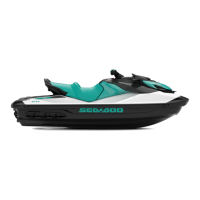
